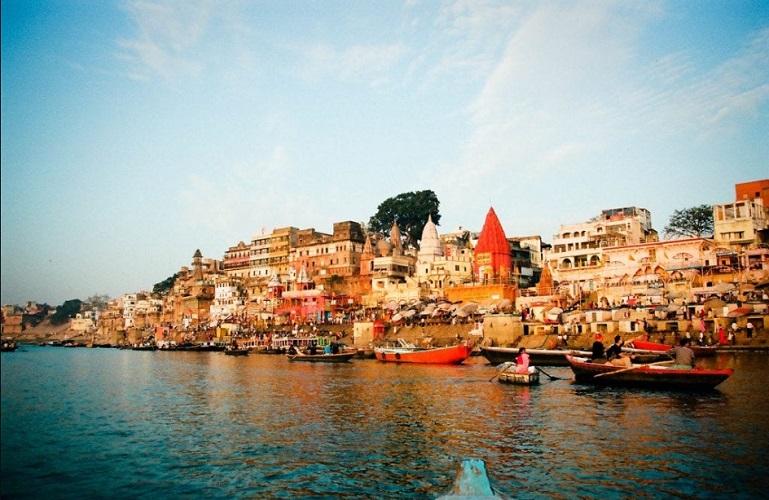National Mission for Clean Ganga approves 7 projects worth ₹692 crore

National Mission for Clean Ganga approves 7 projects worth ₹692 crore
In a recent development, the executive committee of the National Mission for Clean Ganga (NMCG) has given its approval to seven projects with a total worth of ₹692 crore. The ministry of Jal Shakti made this announcement, indicating the government’s continued commitment to the rejuvenation and conservation of the Ganga River.
The approval of these projects took place during the 50th meeting of the executive committee, with G. Asok Kumar, the director general of NMCG, presiding as the chairman.
The National Mission for Clean Ganga is a crucial initiative aimed at restoring the ecological health of the Ganga River and ensuring its sustainable management. Through various projects and efforts, the mission strives to address pollution, enhance water quality, and promote sustainable development along the river’s course.
The approval of these seven projects signifies a further step in the mission’s ongoing efforts to tackle challenges related to the Ganga River’s pollution and degradation. The projects are likely to encompass a range of initiatives, such as wastewater treatment plants, riverfront development, solid waste management, and other conservation measures.
As the executive committee green-lights these projects, it demonstrates the government’s proactive approach to river conservation and its commitment to finding comprehensive solutions for the Ganga’s restoration. The projects’ cumulative budget of ₹692 crore indicates the significant financial resources being allocated to support these conservation initiatives.
The successful implementation of these projects will depend on effective coordination and collaboration among various stakeholders, including government agencies, local authorities, and environmental organizations. Additionally, transparency and accountability in project execution will be critical to ensuring the efficient use of funds and achieving the desired environmental outcomes.

The recent approval of seven projects by the executive committee of the National Mission for Clean Ganga (NMCG) includes a significant focus on sewage management in the states of Uttar Pradesh and Bihar. Out of the seven projects, four are specifically dedicated to addressing sewage-related issues in these two states.
Sewage management is a critical aspect of the Ganga River’s rejuvenation, as untreated sewage is a major contributor to water pollution. By implementing sewage treatment projects in key areas, the NMCG aims to reduce the discharge of untreated wastewater into the river, ultimately improving water quality and environmental health.
The ministry of Jal Shakti highlighted that, thus far, the NMCG has approved a total of 452 projects with a cumulative worth of approximately ₹38,126 crore. Among these approved projects, 254 have already been completed, indicating substantial progress in the mission’s efforts to clean and conserve the Ganga River.
The completion of 254 projects underscores the government’s commitment to effectively implement its Ganga rejuvenation initiatives. These completed projects likely include a diverse range of measures, such as the establishment of sewage treatment plants, solid waste management facilities, riverfront development projects, and other efforts aimed at reducing pollution and restoring the river’s ecosystem.
The NMCG’s continued investment in Ganga conservation through various approved projects reflects the mission’s long-term vision to achieve sustainable and comprehensive river management. The financial commitment of ₹38,126 crore underscores the government’s recognition of the Ganga’s ecological significance and the imperative to protect this vital water resource.
However, the successful outcome of these approved projects will depend on efficient project execution, timely completion, and ongoing monitoring of their impact on water quality and ecosystem health. Ensuring transparency, accountability, and community engagement will also be vital in maintaining the momentum of the Ganga rejuvenation efforts.
As the NMCG continues its mission, it is essential to maintain collaborative efforts with state governments, local authorities, and other stakeholders to maximize the effectiveness of the projects and ensure the sustained well-being of the Ganga River and the communities that depend on it.
During the recent meeting of the executive committee of the National Mission for Clean Ganga (NMCG), specific projects aimed at sewage management in Uttar Pradesh were approved. These three projects have a combined worth of Rs. 661.74 crore and are focused on improving sewage treatment in the state.
The first project involves the creation of a Sewage Treatment Plant (STP) in Lucknow with a capacity to treat 100 million liters per day (MLD) of sewage. STPs play a crucial role in treating and purifying wastewater before it is discharged into water bodies, ensuring that pollutants and contaminants are removed to protect the environment and public health.

Additionally, the approved projects include interception and diversion (I&D) works under the hybrid annuity mode (HAM). I&D works involve intercepting and diverting untreated sewage from its existing pathways, thereby preventing it from entering the Ganga River or other water bodies. This proactive approach to sewage management helps in reducing pollution loads and mitigating the negative impact on water quality.
The implementation of these sewage management projects in Uttar Pradesh is expected to significantly improve the state’s sewage treatment capacity and reduce the discharge of untreated wastewater into the Ganga River or its tributaries. This, in turn, will contribute to the overall efforts of the NMCG in cleaning and conserving the Ganga River and enhancing its ecological health.
The hybrid annuity mode (HAM) is a financing model used to fund infrastructure projects, where a combination of government support and private sector investment is leveraged. This approach ensures the timely execution of projects while sharing the risks and responsibilities between the government and the private sector.
As with any environmental conservation project, the successful implementation of these sewage management initiatives will depend on effective planning, execution, and ongoing monitoring. Transparency, accountability, and stakeholder engagement will also be vital in ensuring the projects’ long-term sustainability and positive impact on the environment.
During the recent meeting of the executive committee of the National Mission for Clean Ganga (NMCG), additional sewage management projects were approved to address wastewater discharges in Prayagraj and Hapur, further contributing to the mission’s efforts in cleaning and conserving the Ganga River and its tributaries.
In Prayagraj, a significant project was given the green light, which involves the interception and diversion (I&D) of the balance discharge from Dariyabad Pipalghat and Dariyabad Kakahraghat drains. Additionally, the project includes the construction of a 50 million liters per day (MLD) Sewage Treatment Plant (STP) in Prayagraj. The total cost of this project is estimated to be around ₹186.47 crore.
The primary objective of this project is to augment the existing treatment capacity of the Naini STP in sewerage district-A in Prayagraj. By constructing the 50 MLD STP and implementing I&D measures, the project aims to effectively manage and treat the balance discharge from the mentioned drains, thereby reducing pollution loads entering the Ganga River. This augmentation of treatment capacity is crucial in further improving water quality and contributing to the overall cleanliness of the river in the region.
In a smaller yet significant project, the approval was granted for a 6 MLD STP, I&D, and other associated works in Hapur. The project’s primary objective is to halt the flow of untreated wastewater from Hapur city drain into the River Kali, which is a tributary of the Ganga River. By intercepting and diverting this flow and constructing the 6 MLD STP, the project seeks to prevent the discharge of untreated sewage into the River Kali and, consequently, the Ganga River. This intervention is expected to positively impact the water quality of the river and the surrounding environment.
The approval of these projects reflects the continued commitment of the NMCG and the government in addressing sewage-related challenges and improving the overall health of the Ganga River and its ecosystem. These projects’ successful implementation will depend on efficient execution, adherence to environmental standards, and active engagement with local communities to ensure long-term sustainability and positive outcomes.

By strategically investing in sewage management infrastructure and promoting responsible environmental practices, the NMCG is working towards its mission of rejuvenating the Ganga River and preserving its cultural, ecological, and economic significance for the benefit of present and future generations.
During the 50th meeting of the executive committee of the National Mission for Clean Ganga (NMCG), another crucial sewage management project was approved to address pollution in the Sirsiya River, which originates in Nepal and enters Bihar at Raxaul in the East Champaran district.
The approved project involves the construction of two Sewage Treatment Plants (STPs) with capacities of 5 million liters per day (MLD) and 7 MLD, respectively. These STPs are aimed at treating the sewage from the Pipra ghat drain and Chhatiya ghat drain in Raxaul town, Bihar. Along with the STPs, the project also includes Interception and Diversion (I&D) works.
The primary objective of this project is to check and control pollution in the Sirsiya River, which has significant cultural and ecological importance for the region. The river’s origin in Nepal and its flow into Bihar make it vital to address pollution issues to protect its water quality and the downstream environment.
By constructing the two STPs and implementing I&D measures for the Pipra ghat and Chhatiya ghat drains, the project aims to treat and manage the sewage before it enters the Sirsiya River. This intervention is expected to significantly reduce pollution loads and improve the river’s water quality, benefiting both the local communities and the ecosystem.
The total estimated cost of the project is ₹74.64 crore, reflecting the financial commitment towards addressing water pollution and promoting cleaner river systems.
This project’s approval demonstrates the NMCG’s continued efforts in enhancing sewage management infrastructure and its commitment to cleaning and preserving important rivers like the Sirsiya River. Effective implementation and timely completion of the project will be essential to achieving the desired environmental outcomes and ensuring the river’s sustained health and vitality.
In collaboration with local authorities and stakeholders, the NMCG’s initiatives in Bihar and other regions along the Ganga River basin are vital steps towards achieving the broader objective of a cleaner and healthier Ganga River and its tributaries. By safeguarding and restoring these water bodies, the mission aims to create a positive impact on the environment and the well-being of the communities that rely on them.




